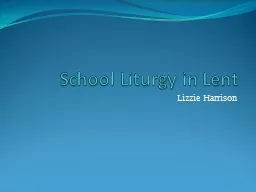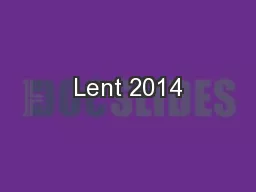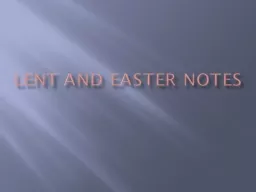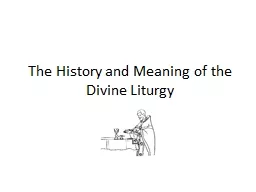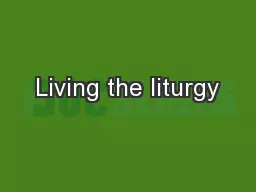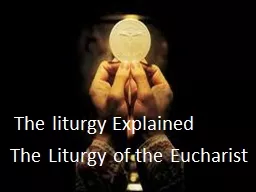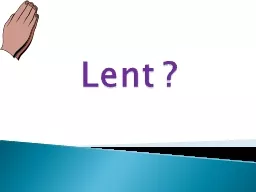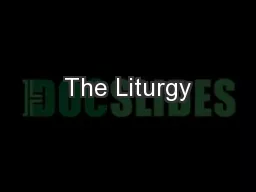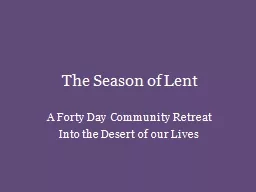PPT-School Liturgy in Lent
Author : myesha-ticknor | Published Date : 2016-05-24
Lizzie Harrison Aims of the Workshop Simple steps to develop any liturgy Elements of ritual Setting up sacred spaces Resources for Lent Why Liturgy Encounter God
Presentation Embed Code
Download Presentation
Download Presentation The PPT/PDF document "School Liturgy in Lent" is the property of its rightful owner. Permission is granted to download and print the materials on this website for personal, non-commercial use only, and to display it on your personal computer provided you do not modify the materials and that you retain all copyright notices contained in the materials. By downloading content from our website, you accept the terms of this agreement.
School Liturgy in Lent: Transcript
Lizzie Harrison Aims of the Workshop Simple steps to develop any liturgy Elements of ritual Setting up sacred spaces Resources for Lent Why Liturgy Encounter God Joy of the Gospel Creative meaningful . MAAR’s Pizza has you covered!. Check Out our Meatless Entrées & Appetizers!. C. heese . L. asagna. A. lfredo Pasta. Spaghetti. Spaghetti Casserole. V. eggie Pizza. M. oon Pizza. Shrimp Pizza. C. Agenda. Prayer. . What is CRS Rice Bowl? . Important Dates. 2014 materials: . What’s. . NEW. . and. . AWESOME. ?. . Print Materials, Website, Mobile App. . Simple Message: Lenten Fasting can provide Life-saving Aid. What is Lent?. Lent is an event in the Christian calendar, which is observed in the lead up to Easter. It begins on Ash Wednesday*, and lasts for 40 days. . During this time Christians will abstain* from something, as a way to imitate Jesus’ sacrifice on the Cross, and his withdrawal into the desert. . . Lent. Lent is a . 7. . week period (40 days) before Easter. During this time, Christians prepare for the coming of Christ at Easter. It is a time to remember the . passion, death, . and . resurrection of Jesus. Just for Parents . Becca Meagher. Our Time Together. Lectio. . Divina. History / Purpose of Lent. Sundays of Lent. Pray / Fast / Give ideas and implementation. Discussion – Sharing – questions. The Word of the Lord. Reflection week beginning 8 February 2016. Lent begins on 10. th. February. What does lent mean to you?. Giving up chocolate?. Preparing for Easter? . Nothing ?. 40 days of preparation. For Christians, Lent reminds them of Jesus spending 40 days in the desert to prepare for his life’s work.. “Liturgy” in Ancient Greece. Leitourgia. – . “performance of a public duty” (usually by a wealthy member of society). Two main categories: 1) annual religious and sporting events, and 2) military supply as needed. Carmel Pilcher . rsj. Carmel.Pilcher@sosj.org.au. How you might foster self giving love (liturgy) in the school community. LIBERATING EDUCATION . We open hearts and minds, through quality teaching and learning experiences, so that through critical reflection and engagement each person is hope-filled and free to build a better world for all. The Liturgy of the Eucharist. The liturgy Explained. The Liturgy of the Eucharist. Offertory comes from the Latin word . Offerre. meaning to present, bring, or to offer. 155 A.D. St. Justin Martyr mentioned the custom of someone bringing bread and wine to the priest after the intercessory prayers.. ?. Some Facts on what Lent is about. Lent is about trying to do sacrifices like Jesus.. Lent is a time when God asks us to come closer to Him in friendship.. Lent lasts for 40 days.. It leads to the greatest feast in the Christian calendar.. of the Hours. The . Sacraments. Document #: TX002086. JOURNAL QUESTION:. Make a list of as many “milestones” or important events that take place throughout your high school years. Which one of these events, in your opinion, should be celebrated more than it is?. words:. “Remember that you are dust and to dust you shall return. ”. It reminds us that one day we will be with him forever in heaven. . Watch . me. !. Lent starts on Ash Wednesday. During Lent we try to get closer to God through:. . When. . where. Leader. Telephone. Tuesdays 10am . Church Lounge. Ann . Bendall. . 0208 845 6961. Tuesdays 8pm . 2 Yeading Avenue. Pam Storey. 0208 868 9624. Tuesdays. 8pm. 40 Westwood Ave. Paul Hart & Sue McLeod. Into the Desert of our Lives. What’s it all About?. . FASTING. PRAYER. ALMS-GIVING. Penance, Discipline. Quiet, Solitude. Subtracting Something. Adding Something. Sacrifice. Scrutiny. Changing Old Habits.
Download Document
Here is the link to download the presentation.
"School Liturgy in Lent"The content belongs to its owner. You may download and print it for personal use, without modification, and keep all copyright notices. By downloading, you agree to these terms.
Related Documents

